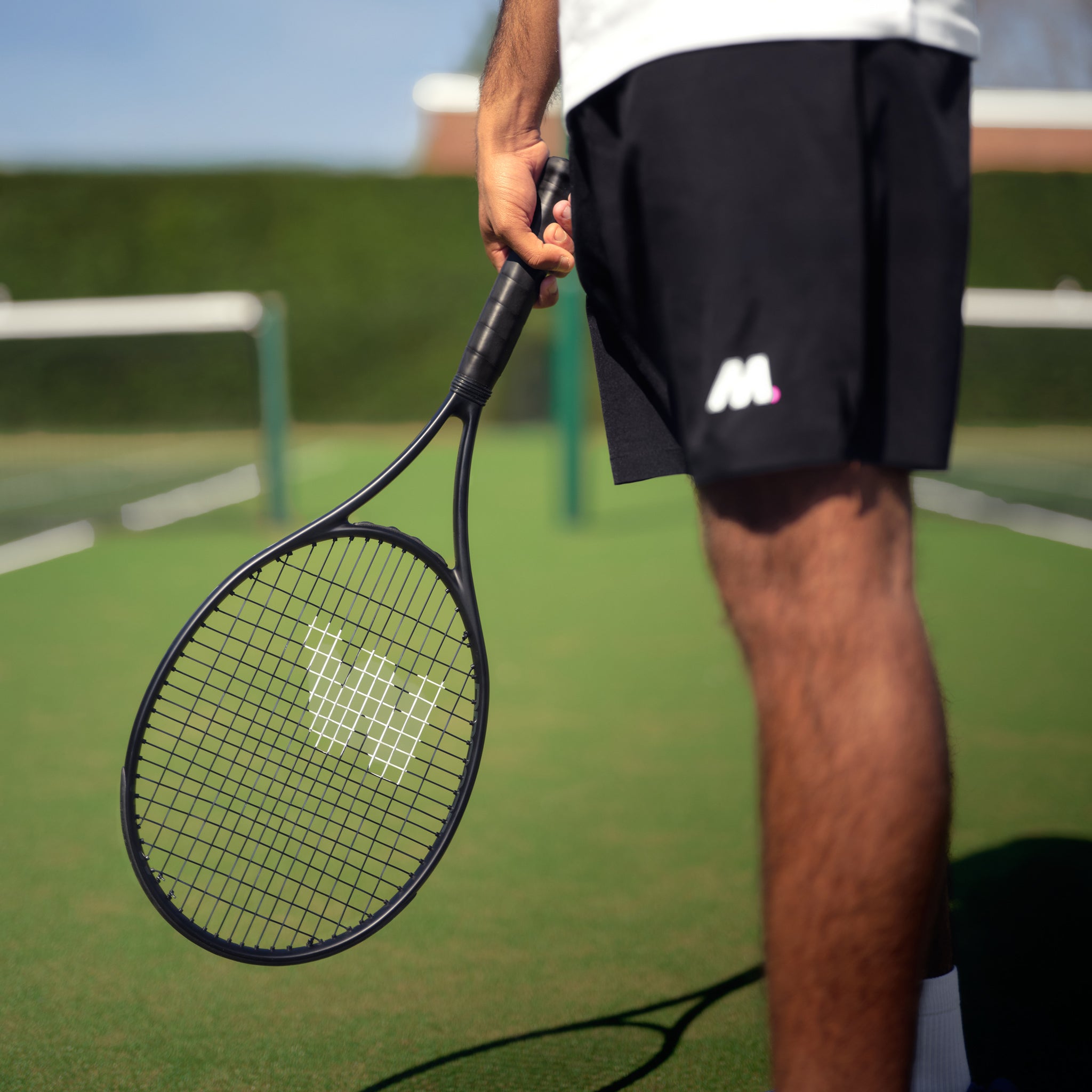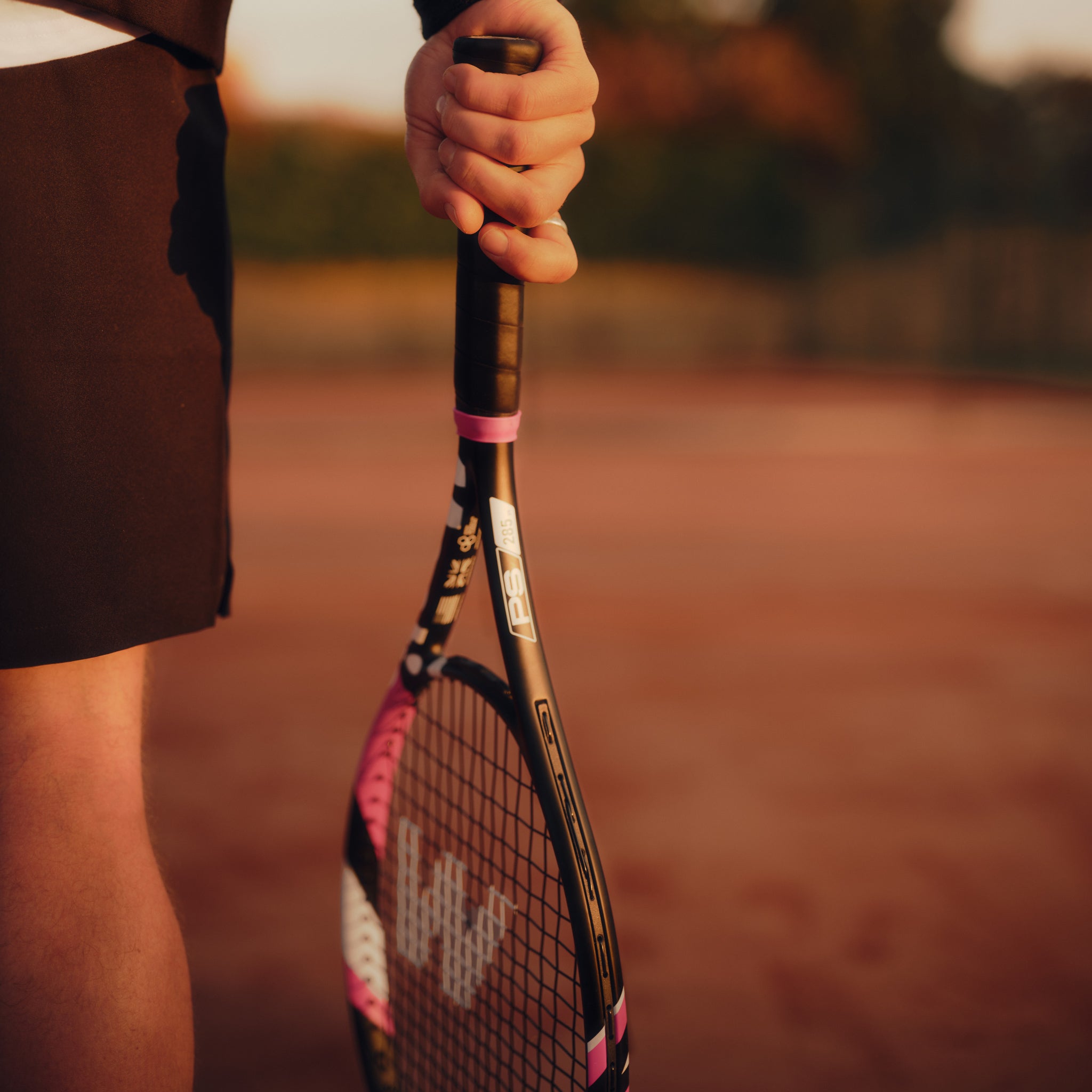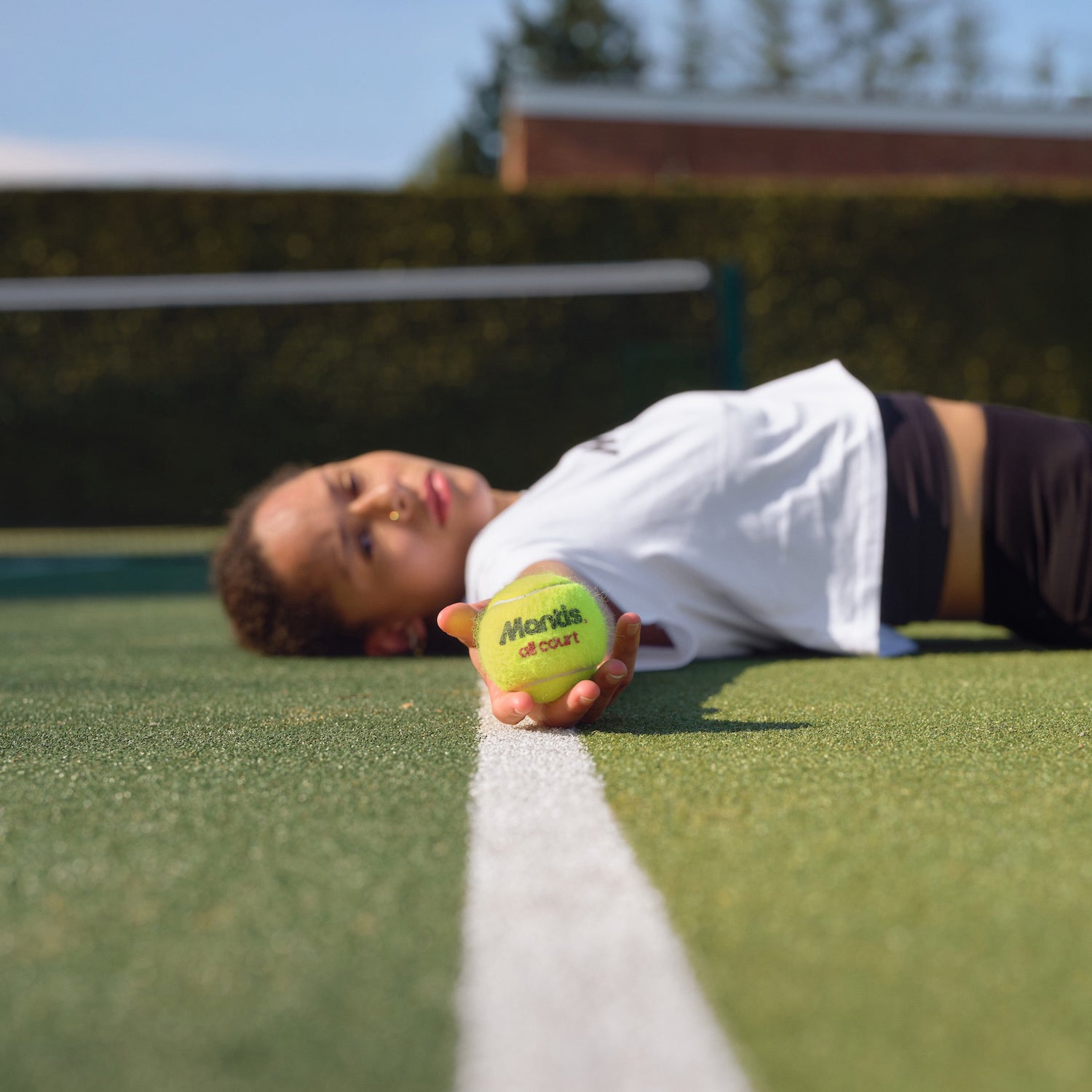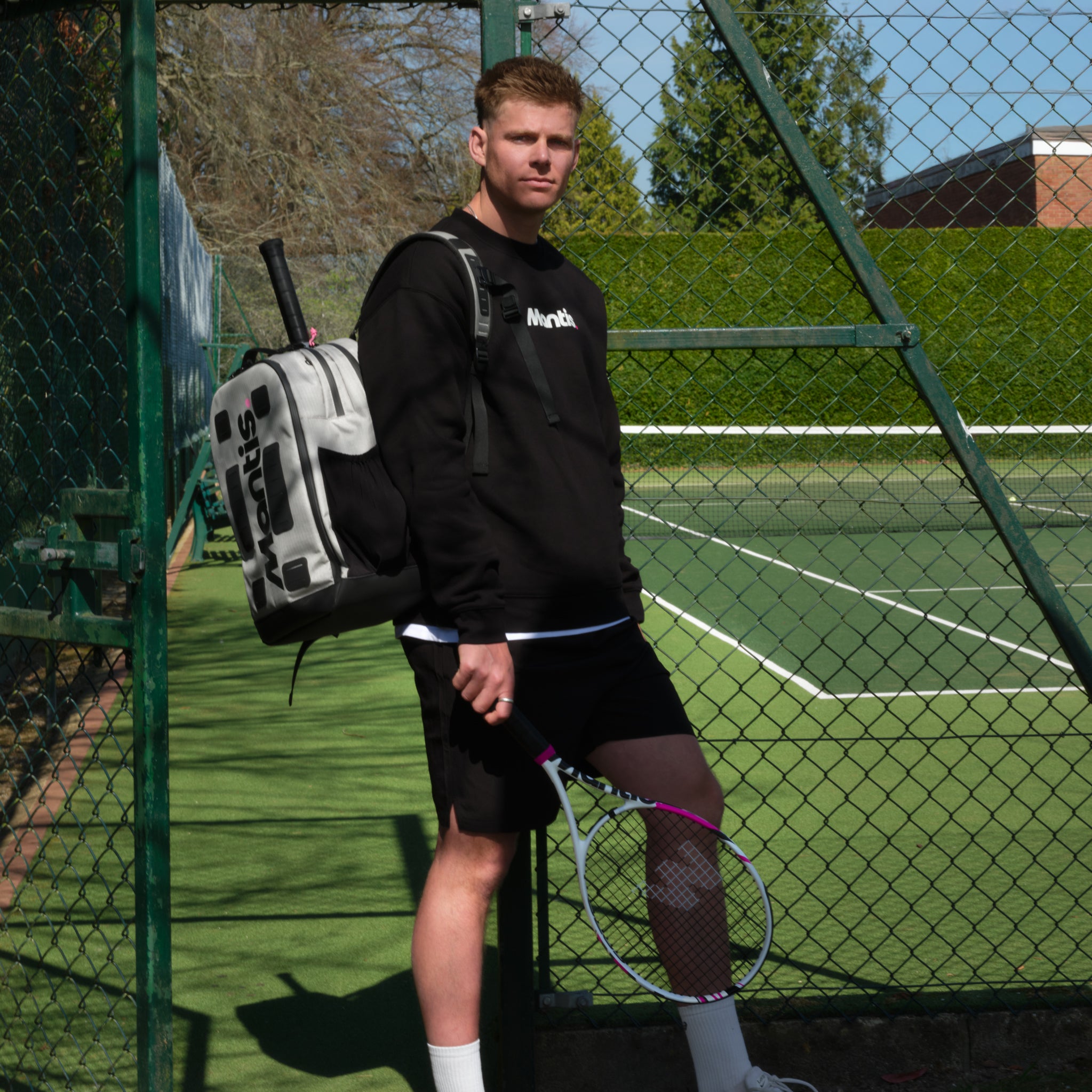
Picking the right tennis racquet can feel like navigating a minefield of technical specs, but if you focus on one key element—tennis racquet head size—you can cut through the noise and instantly find a frame that works for your game. At Mantis, we see a racquet as an extension of the player, and this guide will show you why head size is arguably the most critical choice you'll make. For a bird's-eye view of how all the specs work together, our guide on understanding tennis racquet specifications is the perfect starting point.
Why Racquet Head Size Is Your Most Important Choice
When you’re looking for a new racquet, it’s easy to get bogged down in details like weight or balance. But honestly, the head size has the most immediate and noticeable impact on how a racquet feels and performs on court. Measured in square inches, this single number defines the size of your hitting area—what we all know as the 'sweet spot'.
Here’s a simple way to think about it: imagine the difference between a small, hand-held trampoline and a massive, backyard one. The big one gives you way more bounce (power) and a huge margin for error if you don't land perfectly in the centre. The small one? It demands precision but gives you a much more direct, controlled rebound. That’s the fundamental trade-off of head size in a nutshell.
The Core Performance Factors
The size of the racquet face directly influences a few key parts of your game. Getting your head around these connections is the first step toward picking a racquet that helps your playing style instead of fighting against it. As a rule of thumb, a larger head size gives you a bigger sweet spot, which is a lifesaver on those off-centre shots. It’s simply more forgiving.
On the flip side, a smaller head size has a more concentrated sweet spot. It rewards clean, precise ball-striking with an incredible feel and pinpoint control. This is exactly why you see such a range of head sizes being used, from local club players right up to the pros on tour.
A racquet’s head size is the control dial for its power and forgiveness. A larger head generates more effortless power and offers a bigger margin for error, making it ideal for developing players. A smaller head provides the precision and feedback that advanced players require to place the ball with accuracy.
This relationship between power, control, and forgiveness is the central idea you need to grasp. It’s the reason why two racquets with the exact same weight can feel worlds apart when you hit with them. It all comes back to how the string bed interacts with the ball, and that interaction starts with the dimensions of the racquet head.
From Wooden Classics to Modern Power Weapons
The story of the tennis racquet is really a story of its head size. Watching the frame evolve from classic wood to modern graphite is a fascinating look into technological ambition, and it gives us crucial context for the choices we have today. At its heart, it’s always been about striking the right balance between raw power and refined player skill—a principle we build our Mantis designs around. For a bird's-eye view of how all the specs work together, our guide on understanding tennis racquet specifications is the perfect starting point.
For decades, tennis was a game of wood. The frames from that era look almost delicate by today's standards, typically featuring a tiny head size of around 65 square inches. If you've ever tried to hit with one, you'll know it demands incredible precision. The player had to generate all the pace, as the racquet itself offered very little help.
The Game-Changing Shift to Larger Heads
Everything changed with the arrival of new materials. First came aluminium in the 1970s, and then graphite composites completely rewrote the rules. These materials shattered the design limits of wood, allowing manufacturers to build much larger, more stable racquet heads without making them ridiculously heavy.
This breakthrough in material science was the key that unlocked bigger sweet spots and far more accessible power. Here in the UK, the shift was dramatic. British-made wooden racquets had always stuck to that small, 65-square-inch standard. But as metal and graphite frames appeared, UK players quickly embraced larger heads of 85 to 95 square inches to get more forgiveness and punch behind their shots.
This wasn't just a small adjustment; it fundamentally changed how tennis was played, making the sport faster and more aggressive than ever before.
From Precision Tools to Power Weapons
This evolution created a clear fork in the road for racquet design. The smaller wooden heads were precision instruments. They rewarded players who could consistently find that minuscule sweet spot with sublime feel and pinpoint control.
In stark contrast, the new, larger heads were power weapons. They introduced a huge "trampoline effect," where the bigger string bed could flex more on impact, launching the ball with explosive speed. This didn't just transform the professional tour; it made the game far more enjoyable for beginners and club players who no longer had to be perfect on every swing.
The leap from wood to graphite wasn't just about switching materials—it was about reshaping the very physics of the game. A larger head gave players a bigger margin for error and an entirely new source of power.
Understanding this history is essential because it explains why we have such a diverse market today. Every head size you see is a direct result of decades of innovation, all aimed at solving that timeless puzzle: how to perfectly balance the surgical accuracy of a small frame with the raw power of a large one.
Breaking Down Midsize, Midplus, and Oversize Racquets
So, now we know how racquet design got here, let's look at what you’ll actually find on the shelves today. Every tennis racquet head size is built to offer a specific mix of power, control, and forgiveness. Here at Mantis, we design frames across all the main categories to make sure every player can find their perfect match. For a bird's-eye view of how all the specs work together, our guide on understanding tennis racquet specifications is the perfect starting point.
The three big classifications all come down to the surface area of the string bed, measured in square inches. For a deeper look at how head size works with other key specs, our complete guide to understanding tennis racket specifications is a fantastic starting point.
The Precision of Midsize Racquets
Midsize racquets are the ultimate control frames, typically falling between 85 to 94 square inches. Think of them as scalpels. They’re precision tools for advanced players who generate their own power and find the middle of the strings with their eyes closed.
The trade-off for all that control is a smaller, much denser sweet spot. While this gives skilled players incredible feel and feedback for pinpoint accuracy, it's also brutally unforgiving. Catch a shot off-centre, and you'll feel it immediately in a loss of power and stability.
The All-Round Performance of Midplus Racquets
Moving up, we have the Midplus category, which covers 95 to 105 square inches. This is, by far, the most popular and versatile head size on the market. These racquets hit the sweet spot between power and control, making them a brilliant choice for almost everyone, from intermediate club players right up to touring pros.
A midplus frame gives you a generous sweet spot—offering plenty of forgiveness when you don't strike it perfectly—but still provides enough feedback to feel connected to the ball. This blend makes it the go-to for players wanting an all-court weapon that feels just as comfortable crushing baseline rallies as it does feathering a drop volley.
For most players, a midplus racquet offers the best of both worlds. It provides enough power to be competitive without sacrificing the control needed for consistent, well-placed shots.
You can see how a larger surface area creates a bigger trampoline effect for more power, while a smaller head tightens everything up for pure accuracy.
The Forgiveness of Oversize Racquets
Last but not least, Oversize racquets are anything 106 square inches or larger. These frames are designed with two things in mind: power and forgiveness. The massive sweet spot makes it much, much easier to make solid contact, even if your timing or footwork is a little off.
This makes them a fantastic choice for beginners, juniors, or players with shorter, more compact swings. The larger string bed acts like a catapult, generating serious power with very little effort. It helps developing players get the ball over the net, enjoy longer rallies, and build confidence. You do sacrifice the pinpoint control of a smaller frame, but the user-friendly nature of an oversize racquet makes the game more fun and accessible.
To make it even clearer, here’s a quick breakdown of how each category stacks up.
Tennis Racquet Head Size Performance Comparison
| Head Size Category | Size Range (sq. in.) | Primary Benefit | Ideal Player Type |
|---|---|---|---|
| Midsize | 85 - 94 | Control & Feel | Advanced players with long, fast swings |
| Midplus | 95 - 105 | Balance & Versatility | Intermediate to advanced all-court players |
| Oversize | 106+ | Power & Forgiveness | Beginners or players with compact swings |
Ultimately, choosing the right head size is about finding the frame that complements your natural game and helps you feel confident on the court.
The Physics of Power Versus Control
When you boil it all down, choosing a racquet comes back to one fundamental trade-off: power versus control. Your racquet's head size is the main dial for tuning this balance, and getting your head around the physics is the key to finding a frame that works with you, not against you. For a bird's-eye view of how all the specs work together, our guide on understanding tennis racquet specifications is the perfect starting point.
At Mantis, we're big believers that understanding this dynamic helps you match your racquet to your goals. It’s how you turn a piece of equipment into a genuine asset on the court.
Think of your racquet’s string bed as a trampoline. It’s a simple analogy, but honestly, it’s the best way to visualise what’s happening at impact. It’s a concept that directly links head size to the two most important things you want from any shot.
The Trampoline Effect and Generating Power
A bigger head size, like you’d find on an oversize racquet, creates a larger, more flexible string bed. When the ball hits the strings, they can sink deeper before snapping back, just like a big, bouncy trampoline. This creates a powerful catapulting action, firing the ball off with more speed and depth.
This is what we call the trampoline effect, and it's why oversize racquets are brilliant for generating effortless power. The bigger surface area lets the strings move more, meaning the racquet does more of the work for you. Players with shorter, more compact swings get a huge boost from this, as it helps them hit deep, penetrating shots without having to swing for the fences.
A larger string bed acts like a high-performance trampoline, sending more energy back to the ball. This gives you more power for less physical effort, but that extra propulsion can sometimes come at the cost of pinpoint accuracy.
This increased string movement doesn't just add power; it also increases "dwell time"—the tiny fraction of a second the ball stays on the strings. This can improve feel and spin potential, as the strings have a little more time to grab the ball. But this is also where the trade-off really starts to show.
How a Firmer String Bed Delivers Control
Now, picture a smaller, tighter trampoline. That’s exactly how a midsize racquet with its smaller head and denser string pattern behaves. The string bed is firmer and flexes far less on impact, which gives you a much more direct and predictable response.
This is where control comes from. Instead of a big, explosive launch, you get crisp feedback that travels right to your hand. Skilled players live for this connection because it lets them make tiny adjustments and place the ball with surgical precision. The response is consistent, rewarding clean strikes with incredible command over where the ball goes.
Because the string bed isn't as springy, the player has to generate more of their own pace with a longer, faster swing. This is why you'll see advanced players favouring midsize and smaller midplus frames—they already have the technique to create power, so they prioritise the pinpoint accuracy needed to finish points. The racquet becomes a precision tool, not just a power source. This is the core principle we build on when engineering Mantis frames for competitive play.
Matching Head Size to Your Playing Style
Your racquet should feel less like a piece of equipment and more like a partner, one that enhances your strengths and complements your natural game. Getting the tennis racquet head size right is the key to finding that perfect synergy. It’s the difference between fighting your frame and feeling like it's a natural extension of your arm. For a bird's-eye view of how all the specs work together, our guide on understanding tennis racquet specifications is the perfect starting point.
To find your match, you need to connect the different head size categories to how you actually play. It starts with an honest look at your own game.
Are you an aggressive baseliner who loves to dictate rallies from the back of the court? Or are you more of an all-court tactician who thrives on variety and feel? The answer will point you straight to the head size that will help you play your best tennis.
For the Aggressive Baseliner
If you patrol the baseline, generating your own pace with long, fast swings, you’ll likely feel right at home with a midplus racquet (95-105 sq. in.). These frames offer a fantastic blend of power and control, which is exactly what a baseliner needs.
Think about it: you already have the technique to create racquet head speed, so you don’t need the raw, untamed power of a massive frame. A midplus gives you just enough pop to hit heavy, penetrating shots while still offering the precision to paint the lines and find sharp angles. Plus, the slightly larger sweet spot is a welcome bit of forgiveness during those rapid-fire baseline exchanges.
For the All-Court and Net Player
On the other hand, if you’re an all-court player who relies on touch, feel, and quick hands at the net, the surgical precision of a midsize racquet (85-94 sq. in.) is probably more your speed. These smaller frames are far more manoeuvrable, making them perfect for snappy volleys and crafty drop shots.
The enhanced feedback from a smaller head gives you a much better connection to the ball. This builds the confidence you need to execute those delicate shots with pinpoint accuracy. You do sacrifice some forgiveness, but for skilled touch players, the trade-off for superior control is almost always worth it.
Your playing style is the blueprint for your ideal racquet. A baseliner needs a blend of power and control for rallies, while an all-court player needs the feel and manoeuvrability to command the net.
For Beginners and Developing Juniors
For anyone just starting their tennis journey, the main goal is simple: make contact and have fun. This is where oversize racquets (106+ sq. in.) are brilliant. Their huge sweet spot provides a massive margin for error, helping new players make solid contact more often and build confidence with every swing.
This user-friendly design makes the sport so much more enjoyable right from the first lesson. In fact, UK tennis coaching centres reported that 65% of junior players used racquets between 95 and 110 square inches to get the right mix of power and control. It just makes learning easier, helping new players sustain rallies and fall in love with the game.
How to Choose the Right Head Size for You
Alright, we’ve covered the theory. Now it’s time to connect it all to the court and figure out what’s right for you. Picking the perfect tennis racquet head size is a personal journey, but a simple self-assessment can point you in the right direction, helping you find a Mantis racquet that feels like a natural extension of your arm. For a bird's-eye view of how all the specs work together, our guide on understanding tennis racquet specifications is the perfect starting point.
For a complete picture of all the specs that matter, our post on how to choose a tennis racket is a great place to start.
First things first: be honest about your skill level. Are you just getting into the swing of things, a seasoned club player, or an advanced competitor who has been playing for years? Your answer here will immediately narrow down your options.
Assess Your Swing Style and Goals
Next, think about your swing. Is it long, fluid, and fast—the kind that generates its own pace? Or is it more compact and short? Players with shorter swings often find the extra pop from a larger head size a huge help, while those with full, fast swings might prefer the pinpoint control a midplus frame offers.
Finally, what are you trying to accomplish on court?
- For Consistency: If you’re a club player trying to cut down on unforced errors and just get more balls back in play, the forgiveness of an oversize or larger midplus head (102-110 sq. in.) will be your best friend.
- For All-Court Versatility: Looking for a balanced frame that feels just as good at the baseline as it does at the net? A classic midplus racquet (98-100 sq. in.) gives you that ideal blend of power and control.
- For Precision and Feel: For competitive players who need surgical accuracy to hit their spots, the control that comes from a smaller midplus or midsize head (95-98 sq. in.) is essential for executing a high-level game plan.
Choosing the right head size is about aligning the racquet's features with your personal needs. It's not about what the pros use, but about what gives you the most confidence to hit your shots.
By thinking through these three things—your skill, your swing, and your goals—you can move past the technical jargon and make a decision that truly fits your game. At Mantis, we believe this simple self-check is the key to finding a racquet that not only boosts your performance but, more importantly, makes the game more fun.
Common Questions About Racquet Head Size
Picking the right racquet often comes down to a few key questions. To help you feel completely confident in your choice, we’ve gathered the most common queries we hear at Mantis from players just like you, along with clear, straightforward answers. This should clear up any final points of confusion. For a bird's-eye view of how all the specs work together, our guide on understanding tennis racquet specifications is the perfect starting point.
For more insights like these, check out the latest advice on our Mantis tennis news blog.
Does a Larger Head Size Generate More Spin?
Yes, a larger head size generally helps create more spin. The wider string spacing on a bigger racquet face allows the strings to grip or "bite" the ball more effectively on contact. This little bit of extra grab is what helps you generate heavy topspin on your groundstrokes and a wicked slice on your serves.
What Head Size Do Professional Players Use?
You’ll find that most professional players use midsize to midplus racquets, typically between 95 and 100 square inches. Because their technique is so advanced, they can generate all the power they need on their own. What they’re really looking for is the superior control and feel that a smaller head provides, giving them the pinpoint accuracy to hit their targets.
Should a Beginner Start with an Oversize Racquet?
Absolutely. An oversize racquet, which is anything 106 square inches or larger, is an excellent choice for most beginners. The larger sweet spot is incredibly forgiving on off-centre hits, which makes it much easier to keep the ball in play while you're still developing your swing.
On top of that, the extra power it provides helps you get the ball over the net with a more compact, simple swing. This just makes the game more fun and less frustrating while you’re busy learning the fundamentals.
How Do I Know if My Racquet Head is Too Small?
There are a few tell-tale signs. If you’re frequently mishitting the ball off the frame, feel like you have to swing for the fences just to get any power, or notice harsh vibrations on off-centre shots, your racquet head is probably too small for your game. Making the switch to a slightly larger head size could give you the forgiveness and comfort you’re missing.








